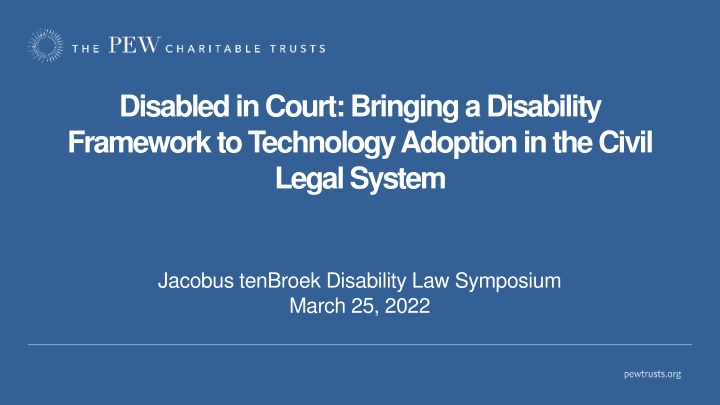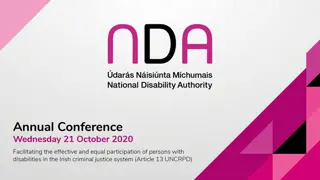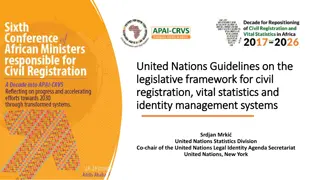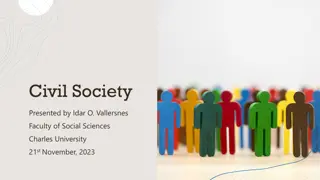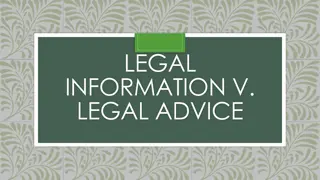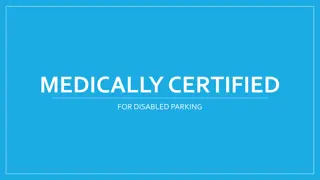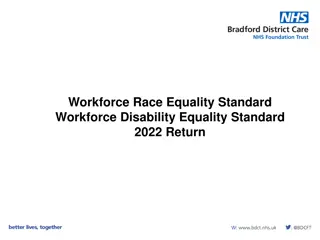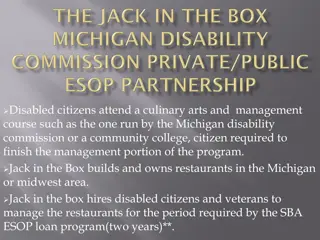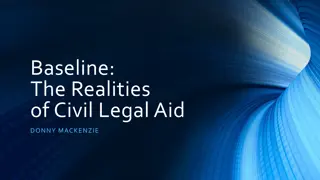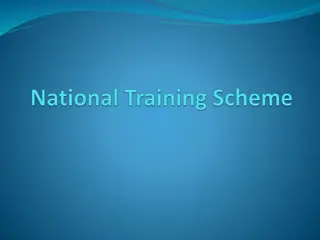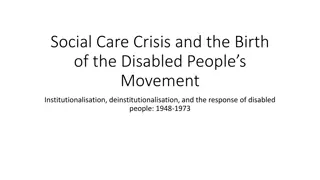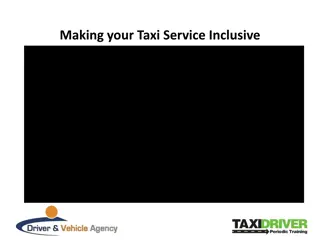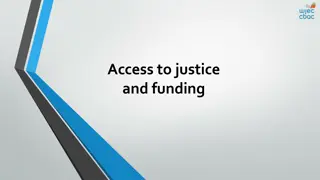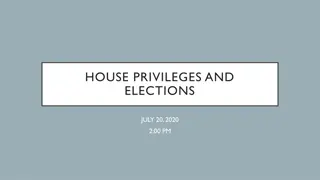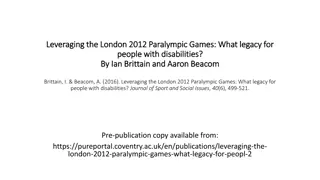Technology Adoption in Civil Legal System for Disabled Individuals
Technology can enhance access to civil courts for disabled individuals, the Jacobus tenBroek Disability Law Symposium delves into a new modernization framework. The presentation by Pew Charitable Trusts addresses the intersection of technology, court access, and disability rights. With a focus on improving outcomes for those involved in the civil legal system, the project aims to develop innovative solutions to address pressing challenges faced by individuals with disabilities.
Download Presentation

Please find below an Image/Link to download the presentation.
The content on the website is provided AS IS for your information and personal use only. It may not be sold, licensed, or shared on other websites without obtaining consent from the author.If you encounter any issues during the download, it is possible that the publisher has removed the file from their server.
You are allowed to download the files provided on this website for personal or commercial use, subject to the condition that they are used lawfully. All files are the property of their respective owners.
The content on the website is provided AS IS for your information and personal use only. It may not be sold, licensed, or shared on other websites without obtaining consent from the author.
E N D
Presentation Transcript
Disabled in Court: Bringing a Disability Framework to Technology Adoption in the Civil Legal System Jacobus tenBroek Disability Law Symposium March 25, 2022
Getting to know the audience What are some words that come to mind when you hear the term civil court ? What about this topic drew you here today?
Todays presentation 1. About Pew and the Civil Legal System Modernization Project 2. What we ve learned About technology and court access 3. How this research has informed a new civil court modernization framework, and how the framework will incorporate the needs of disabled people 4. Learn from you how civil courts can better meet the needs of disabled people
The Pew Charitable Trusts A public charity driven by the power of knowledge to solve today s most challenging problems. Pew conducts fact-based research and rigorous analysis to improve policy, inform the public and invigorate civic life. We help states apply fact-based solutions to a wide range of policy areas, including the environment, health, consumer safety, and in addressing state policy and economic issues.
Survey of U.S. Households 1 in 3 faced family, housing, or debt issues that could wind up in court 56% had 1 or more problems or disputes that touch the legal system Estimated 3 out of 4 cases that end up in court have at least one side with no lawyer
Civil Legal System Modernization Project Research ways to improve health, housing, and financial outcomes for people involved in the civil legal system Build partnerships with the private sector, policymakers, and other stakeholders Develop and evaluate promising policies, processes, and technologies to improve experiences and outcomes for people who interact with state and local courts
Families Experienced Financial Hardship Due to Pandemic Roughly 1 million people were evicted 9.6 million Americans lost their jobs
Courts Designed By Lawyers, for Lawyers Complicated procedures Legal jargon No right to a lawyer in civil cases
Key Findings 1. Courts use of technology exploded 2. Technology increased participation 3. But technology also disproportionately benefited parties with lawyers 4. And in some states, technology raised new barriers
Use of digital tools Digital tools can help courts streamline processes and help litigants prepare for a resolve cases: E-filing E-notarization Online Dispute Resolution Virtual hearings
Courts Were Slow to Adopt Technology Before the Pandemic Almost no states regularly used virtual hearings 37 states and D.C. allowed people without lawyers to e-file 34 states allowed e-notarization
Courts Use of Technology Exploded in March 2020 50 states and D.C. allow lawyers to e-file 10 additional states create mechanisms for people without lawyers to e-file 11 states and D.C. change notarization policies
Technology Increased Litigant Participation Researchers report increased participation in criminal and child welfare proceedings Court leaders report similar gains in civil proceedings Before the pandemic: 70% of debt collection cases ended in default judgments Arizona: Default judgments drop by 8% between June 2019 and June 2020 Technology was the #1 reason for the increase in participation Majority of judges surveyed in June 2021 expect remote proceedings to become a permanent fixture of state courts
But technology also disproportionately benefited represented parties 8 states did not allow people without lawyers to e-file indebt collection lawsuits 9 states did not allow people without lawyers to e-file in eviction cases 10 states did not allow parents to submit child support modification requests electronically
Technology Raised New Barriers Broadband access: As of 2018, 42 million U.S. adults lacked reliable broadband connectivity, with black and Hispanic communities, as well as rural and tribal communities, disproportionately cut off from reliable access. Technology and disability access: A 2021 Wesleyan University analysis of nearly 10,000 court pandemic emergency orders found: - less than 3% referenced accommodations or resources for people with limited English proficiency - less than 1.5% referenced people with disabilities - none of the documents referenced technology accommodations for these populations
Recommendations Evaluate Reimagine Test
Questions What do you think are some of the challenges that disabled people face in civil courts? What does a modern civil court for disabled people look like to you?
Civil Court Modernization: The need for a common language and set of metrics Court leaders and stakeholders are calling for modernization action, but no standard way talking about what that means Courts are adopting innovations to improve court access Civil legal field lacks standard way to measure progress toward modernizing
Defining our framework Goals and measures courts can adopt to assess progress toward becoming more: Open, by maximizing transparency and data collection to enable ongoing improvements Efficient, by optimizing their limited resources to help litigants engage more effectively Equitable, by ensuring all people who use the courts are on the same footing before the court
Embedding disability into an open court Key Goal: Accessible court data Reform actions: Require court data vendors and web developers to ensure a court user s case information is accessible Progress measures: Court users with disabilities can access their case information securely, with no barriers
Embedding disability into an open court Key Goal: Court analyzes and publish civil case trends Reform action: Adopt uniform data standards that include collecting disability-related data Progress measures: Court can identify trends related to court accessibility for disabled users
Embedding disability into an efficient court Key Goal: Accessible court information Reform action: Examine and improve accessibility of all legal information on court website and in the courthouse Progress measures: Disabled court users can easily find out complete information about their case and court process
Embedding disability into an efficient court Key Goal: Reduce delays and costs for courts and users Reform action: Apply universal design to all new efficiency- related policies, processes, and technology Progress measures: Increase in response and case participation rates across users with disabilities Court users with disabilities report fewer delays with their case due to accessibility issues
Embedding disability into an equitable court Key Goal: Court leaders and stakeholders understand issues around inequities in court access Reform action: Provide trainings and education opportunities for court leaders to learn about disparities in court access e.g., lived experience storytelling, formal disability awareness training Progress measures: Training and oversight of equity-related reforms are institutionalized Survey of court users with disabilities report feeling respected and heard
Embedding disability into an equitable court Key Goal: Court users from marginalized groups can assert their rights and have them enforced Reform action: Routinely study impacts of court processes, policies, and technologies on participation of disabled court users (including intersectionality) Progress measures: Court adapts processes, policies, and technologies based on findings Sustained increase in disabled court users reporting effective participate in their case
Questions Thoughts / Reactions? How would you, or how have you, measured disability and access in the courts?
Thank you! Qudsiya Naqui, Esq. Officer, Civil Legal System Modernization qnaqui@pewtrusts.org Darcy White Senior Officer, Civil Legal System Modernization dwhite@pewtrusts.org
